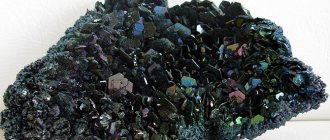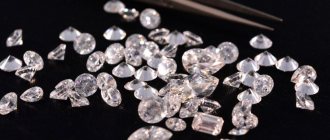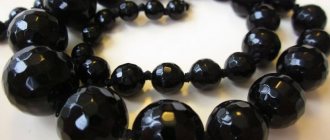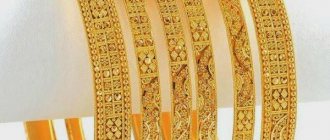Gold, like silver and the six platinum group metals, is a noble or precious metal.
The first definition (noble metals) reflects the property of gold to be extremely reluctant to combine with non-metallic elements, in particular oxygen. Gold also does not react with most acids. In base metals (copper, iron, etc.), interaction with oxygen causes oxidation - changes in structure and appearance. Gold under normal conditions does not react with any natural substances, and therefore does not change its appearance at all over time.
The second definition (precious metals) refers to the combination of rarity, durability and beauty. This is what allowed gold to remain the most expensive metal from the beginning of human history until the 19th century.
General information and history of origin
It is believed that gold is a valuable metal that humanity first became acquainted with in the Stone Age due to its massive distribution in its primary state. The properties of the metal made it possible to make weapons and objects for various purposes from it, which were discovered by archaeologists since ancient times, and dated back to the 4th-5th millennium BC. e.
In the 3rd millennium BC. e. the metal was already known in Egypt, India, China, and Mesopotamia. Ancient jewelry made at that time contained silver, copper and other metals.
Only 6th century. BC e. 99.8% pure gold was found in Egypt. During the Middle Kingdom, Nubian deposits were mined, giving rise to the name Nub gold.
Native gold is the main form of metal found in nature. It is present in hydrothermal deposits, forming gold ores, unevenly distributed in fractured vein quartz and sulfides.
When ores oxidize on the surface of the earth, it dissolves and redeposits. Destruction processes lead to the release of native gold particles and their accumulation in placers.
Flexibility (ductility)
This is one of the most important features that gold has. The properties of metal allow it to be crushed, squeezed, bent, and compressed. Due to its ductility, gold can take different shapes without breaking. From 1 g you can draw the thinnest wire (thread), the length of which will be 2610 m. Its diameter will be only 2 * 10-6 mm, which allows the thread to be used in the modern electronics industry with microchips. The tensile strength of annealed gold is 100-140 MPa.
Chemical, physical, optical properties of gold, classification
Pure gold has low hardness and melts at a temperature of 1064°C . The metal is ductile, malleable, and bends easily. It is also resistant to moisture, does not react with acids, salts, alkalis, but can dissolve in acids (nitric and hydrochloric) in a ratio of 1:3.
It reacts chemically with chlorine, bromine, iodine.
Ductility
It is difficult to say which basic property of gold is most important to us, but we can definitely say that malleability is one of the main ones. Thanks to it, this metal can be turned into a thin sheet. So, from 1 g of gold you can get a plate of thin foil, the area of which will be 1 square. m. This allows it to be used in various fields of human activity. Gold is a metal that can be made translucent and very thin, but it will not lose its beauty and shine. Thanks to this property, it became possible to obtain thin-sheet (leaf) material, which is used to cover the domes of churches and decorate the interior of premises.
Field and production
It is believed that the Egyptians were the first to mine the yellow metal. Chronicles recorded metal mining in the Arabian-Nubian province. Deposits were also found in Spain and Austria-Hungary.
In total, the world produces an average of 2,500 tons of gold per year. The largest deposit is located in South Africa. Up to half of the world's production is extracted here. Next come China, Australia, USA, Peru, Russia, Canada, Mali.
Countries with large natural reserves:
| A country | Reserves (t) |
| USA | 13427,6 |
| Canada | 13367,4 |
| South Africa | 13228,5 |
| Russia | 9306,2 |
| Australia | 7331,8 |
| Chile | 4182,6 |
| Mexico | 3872,8 |
The largest gift to humanity was kept in South Africa (Africa), where an accumulation of about 70,000 tons was discovered in an area measuring 100x270 km in 1873. More than half has already been mined.
Photo and appearance of metal
Grains are gold fractions up to 15 g in size. They have a minimum of impurities, and their extraction is economically efficient.
Do you wear gold?
Pieces weighing more than 15 g are called nuggets. They do not contain pure gold. And impurities can change the color of the metal beyond recognition, which makes it difficult to identify a nugget, and only a specialist can determine whether it belongs to valuable metals.
What color is gold?
Jewelry is not made from pure gold because it is soft and not suitable for daily wear. To eliminate this defect, other substances are added to gold, so it changes its properties, value and shade.
Classification of gold alloys depending on the color palette:
- Yellow gold. Template color for perception. In the jewelry industry, it is supplemented with silver and copper, which increases the wear resistance of products of varying degrees of complexity.
- White gold. This color of metal is mined by incorporating palladium, nickel, silver, and platinum into gold. The alloy with platinum is valuable. Decoration based on it does not collapse, does not deform and retains its attractive appearance for a long time. Nickel products are cheap, they wear worse and can cause allergies.
- Black gold . It can be obtained in certain ways: combining cobalt and chromium, coating it with black rhodium, using a laser pulse, or treating it with amorphous carbon.
- Green gold. This alloy was known in ancient times. It was called electrum - a type of native gold, which was an alloy with silver with a green tint. The share of silver in it, as a rule, predominates. Green metal differs from natural alloys by a pronounced green tint, and some metals according to the well-known standard are in the ratio of 73% gold and 27% silver.
- Red gold . It is produced by adding an alloy consisting of copper and zinc to a valuable metal. Jewelers prefer to use red gold because it is durable, which helps them create exclusive jewelry without worrying about possible deformation.
- Pink gold . An alloy of gold, silver and copper. Many jewelers make real masterpieces from it, attracting the attention of true connoisseurs of jewelry art. It is 585 (58.5% gold, 32.5% copper, 9% silver) or 750 (75% gold, 12.5% copper, 12.5% silver).
- Brown gold. Due to its hardness, this alloy is used to design watch movement cases. As a standard, it has a 585 or 750 sample with a large presence of copper in the rest of the alloy. The brown color comes from repeated chemical treatment of the jewelry. The material acquires a brown tint after special procedures.
Jewelry brands offer a large selection of shades and colors of gold, creating new unusual alloys.
Samples
To determine the quality of metal, a sampling system was invented that shows the volume of pure metal in the product:
- 999 sample . These jewelry are rare and cannot be found in store windows. Due to the minimal impurity content (up to 0.01%), this gold is called “four nines”. Used to create bank bullion.
- 960 sample. Gold leaf. Its chemical properties make it possible to roll metal into ultra-thin sheets. In this case, the product will not have cracks or irregularities, which is due to the increased ductility of the metal. These plates are called tinsel, which is used for decorative purposes and in the food industry (additive E175).
- 958 sample . The alloy contains up to 96.3% gold. Silver and copper act as additional elements. It is characterized by yellow color, plasticity, and resistance to environmental factors. Wedding rings and pendants are made from this sample.
- 750 sample . The alloy contains up to 75.5% of the base metal, other components are platinum, silver, palladium, nickel, copper. The metal is durable and can be polished well, which is why products made from it last a long time and shine brightly.
- 585 sample . This alloy is quite in demand in the jewelry industry. It contains up to 59% gold. It is endowed with hardness, durability and does not fade. Can be white, red, yellow and green, based on the number of proportions of elements included.
- 375 and 500 samples . They are not used in the jewelry industry. Alloys instantly fade in air, losing their shine and attractive appearance, which limits their use.
- 250-333 sample. Due to the insignificant composition of gold, the alloy oxidizes in air and begins to corrode and quickly tarnish. It is used in foreign jewelry production in the manufacture of cheap jewelry for mass demand.
When purchasing jewelry, it is important to check its authenticity. Each product has a special imprint - a stamp where the sample is indicated.
What alloys are there?
Even in ancient times, when minting coins, they used an alloy of gold and silver 4:1 or 3:1. In the modern world, the composition of alloys is supplemented by:
- cadmium (Cd);
- copper (Cu);
- nickel (Ni);
- palladium (Pd);
- platinum (Pt);
- silver (Ag);
- zinc (Zn).
These additives give the necessary color to the alloy and change its properties. The inclusion of silver makes gold viscous and ductile, reduces the melting point, and changes its color. The addition of copper imparts hardness, maintaining malleability and ductility, but at the same time worsens the protective characteristics.
It also gives it a red tint. Palladium guarantees the alloy ductility, malleability, and also changes its color. If the palladium portion is 10%, the color becomes white.
Reflective Features
Gold, whose properties and uses are determined by its chemical composition, is easily polished. It has significant reflectivity. Very thin sheets of gold are able to transmit the sun's rays. Amazingly, they will not heat up at all, since the thermal (infrared) part of them will be reflected from such plates. Thanks to this property, gold has found application in construction. It is used for tinting glass in countries with hot climates. Thanks to this solution, the energy required for air conditioning the premises is significantly saved. The reflective properties of gold are even used in astronautics. It is applied to protective helmets and other surfaces of space equipment to reflect the significant flux of infrared rays in space.
Magical properties and influence on humans
Magical practice has always recognized the strong and insidious energy of gold. Not everyone can handle this power. Gold can both attract wealth and good luck, and lead to death by fogging the mind. For those who are able to cope with it, metal will become a reliable talisman that:
- It will give you such positive qualities as confidence, determination, fairness, and the desire for excellence.
- It will pacify excessive emotions, make a person balanced, able to control outbursts of irritation and anger.
- Helps you think rationally and make the right decisions
- It will get rid of negative influences and protect against the evil intentions of people around you.
Gold helps those who believe in its power, ask for help and express their gratitude.
For women
For women, metal will help them plan their future correctly, correct their fate, and improve their quality of life. Metal makes its owner liberated, freer to choose her path. The girl makes contact better, a lot of fans and admirers appear around her.
For men
Gold will give men self-confidence and success in entrepreneurship and financial matters. Metal will allow you to develop diplomacy, a sense of balance and tact.
Medicinal and beneficial properties
In addition to its physical value, the expensive metal is also credited with having a positive effect on human health. Continuous wearing of gold is believed to help:
- Strengthen the body's defenses.
- Normalize thyroid function.
- Stabilize the functioning of the heart and vascular system.
- Eliminate deafness, improve vision.
- Cure respiratory diseases.
- Increase activity and performance.
- Stimulate brain activity, improve memory.
- Lift your mood, invigorate, protect against depression, relieve symptoms of chronic fatigue.
It is recommended to use gold for medicinal purposes for those who do not have an individual reaction to it . As a result of metal intolerance, skin allergies, depression, deterioration of hair growth and even tooth decay can occur.
How and who is recommended to wear gold
In order for gold jewelry to give you only pleasure, complement your image, style, and emphasize your status, you need to wear it correctly and not neglect the general rules.
Zodiac sign
Gold has a great influence on a person’s destiny, so you should know which sign it suits.
- According to astrologers, metal will become a reliable amulet for such zodiac signs as Leo , Taurus , Aries , as it helps its owners overcome any difficulties in life with faith in their own strength.
- Virgo , Cancer , Libra , Pisces should limit wearing gold; it is better for them to give preference to silver.
- Read more about each zodiac sign here .
All other zodiac signs can safely, without fear, use the valuable metal and its healing and mystical power.
What stones and metals is metal compatible with?
To enhance the positive impact of the product, when choosing jewelry, you need to know which stones gold is compatible with.
The noble alloy harmonizes with diamond, lapis lazuli, ruby, hyacinth, amber of various shades, and transparent peridot.
You cannot combine gold with jade, emerald, garnet, languid pink topaz, or jasper. Since gold cannot withstand high-density, dark-colored minerals that block the passage of the sun's rays.
Electrical conductivity
Using this property of gold allows it to be used in the electronics industry. This metal has high electrical conductivity. At the same time, it is resistant to oxidation. The electrical conductivity of gold relative to copper is 75%. Resistance at 0ºC - 2.065 * 10-8 Ohm. This main property of gold allows it to be used in the production of such complex electronic devices as mobile phones, televisions, computing equipment, calculators, and computers. The thermal conductivity of the noble metal at 0ºC is 311.48 W/(mK).
This is interesting
Interesting information about gold:
- The purity of the metal is determined in carats. The origin of this term comes from the name of the carob seeds. They are used for weighing in the Middle East. The weight of a bean, which is called a carat, is 1.5 g. The weight of gold in carats is 10, 12, 14, 18, 22 or 24. The higher the indicator, the better the quality of the metal.
- Metal is able to conduct heat and electricity well and does not rust.
- The largest gold nugget was found in Australia in 1872. This sample measures 25x63 cm and weighs 70 kg. He was given the name “The Long-awaited Wanderer.”
- Back in the 7th century BC. e. Dentists from Italy began to use gold wire to insert teeth.
- The Aztec word gold meant “experiments of the gods.”
- Window glass is coated with gold because it reflects the sun in summer and retains heat in winter.
- Gold leaf is edible and is used in cooking to decorate desserts.
- About 10 billion tons of the element are concentrated in the oceans, but they have not yet figured out a way to extract it from such depths.
Gold is in high demand all over the world due to its intrinsic beauty, rarity, physical and chemical properties.
What stones go best with gold in jewelry?
18K Gold Carved Ruby Ring by ARTISAN
Gold is so versatile that it goes well with all stones. An exception is aquamarine on white gold - on it it is almost invisible and is lost from attention, but some will like this option. Also, some consider it unacceptable to combine bright red stones (for example, garnet or ruby) with yellow gold. But, again, this is a matter of taste.











